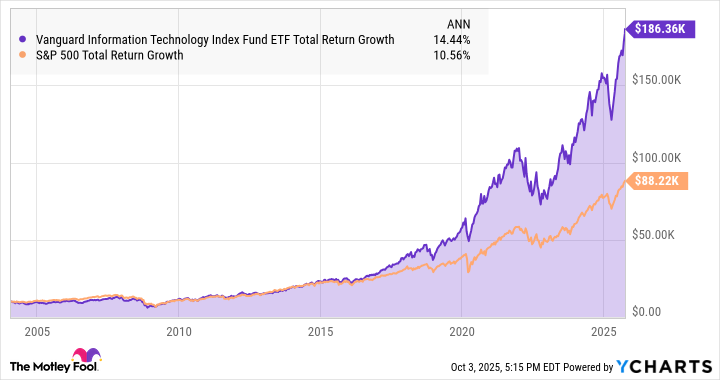Look, I get it. The stock market feels wobbly right now, like the broader economy. Your instinct with $10,000 to invest is probably screaming "play it safe!" So you're eyeing those stable dividend-heavy exchange-traded funds (ETFs), maybe some bonds, perhaps a nice balanced fund that won't keep you up at night.
But what happens when smart investors get too cute trying to sidestep corrections? They miss the rebounds that matter most.
I'm not just making this up. Those who sold their growth stocks in 2022 because they thought the market was in for a deep and lasting recession in the inflation crisis have missed the biggest wealth-building surge in history.
So I'm not exploring the deep-discount value shelves when perusing Vanguard's low-fee ETFs right now. Come rain or shine, Vanguard's biggest long-term winners have a proven history of overcoming terrifying price drops over time. That's why I keep coming back to the Vanguard Information Technology Fund (VGT 1.12%), even in this shaky economy.
The numbers scream "danger"
At first glance, the Vanguard IT Fund looks like a strange buy when you're expecting market turbulence. Let me compare the ETF's portfolio metrics with those of the S&P 500 (^GSPC 0.35%) tracker around the corner, the Vanguard S&P 500 ETF (VOO 0.33%):
|
Metric |
Vanguard IT Fund |
Vanguard S&P 500 Fund |
|---|---|---|
|
Number of stocks |
316 |
504 |
|
Net asset value (NAV) |
$128 billion |
$1.4 trillion |
|
Beta value |
1.25 |
1.0 |
|
Median market cap |
$635 billion |
$368 billion |
|
Average price-to-earnings (P/E) ratio |
39.0 |
27.7 |
Data collected from Vanguard on 10/3/2025.
The IT fund is smaller in many ways, with fewer stocks and a lower asset value. That said, its average holding is a larger company with a much richer P/E ratio. Oh, and its Beta value is 25% higher, indicating a much more volatile ETF. In this light, it doesn't look good for risky markets at all.
Price drops can be brutal
This ETF can really hurt when the market turns dark.
Imagine buying the IT Fund just before the onset of the inflation panic in 2022. By mid-October that year, you would have lost 34% of your original investment -- and that's the total return with the added value of reinvested dividends along the way. The S&P 500 Fund took a smaller 20% hit in that period.
But if you held on through that storm, you'd have a market-beating total return of 70% from the end of 2021 to October 3, 2025. The S&P 500 and related index funds only gained 49% in that span of nearly four years -- started at a terrible time (in hindsight).
Three crashes, three recoveries, one clear pattern
I didn't cherry-pick that market crisis, by the way. I could run the same experiment around the pandemic crash in 2020 or the subprime mortgage meltdown of 2008 with similar results. The volatile IT fund may fall harder and faster at first, but it has always come back swinging in the long run.
This is Vanguard's best-performing ETF in the last year, the past 3 years, and the last decade. That's a pretty consistent outperformance from an inherently volatile ETF. And what if you invested $10,000 in Vanguard's IT Fund at the January 2004 launch and left it alone for 21 (nearly 22) years? Well, you'd more than double the total returns of a similar investment in the S&P 500:
VGT Total Return Level data by YCharts
Are you brave enough to bet on Vanguard's top performer today?
With the Vanguard IT Fund trading at $755 per share, your $10,000 will buy about 13 full shares. Whether you grab a few shares now and add more during the next inevitable dip, simply build a small position that's left untouched for a long time, you're making a smart choice about your financial future. Even with horrible market timing, this ETF tends to deliver market-smashing returns in the long haul.
The Vanguard Information Technology Fund isn't for everyone. If you need this money in the next three years, look elsewhere. If watching your investment drop 30% will make you panic-sell, stick with the Vanguard S&P 500 fund or something even tamer.

Image source: Getty Images.
But what if you can genuinely commit to a five-year-plus timeline, understanding that volatility is temporary but the infrastructure of tomorrow's economy keeps growing anyway? Then this fund's 0.10% expense ratio gives you dirt cheap access to the market's most powerful wealth-creation engine -- American growth stocks.
The market feels shaky. It always does when you're about to invest, right? Don't let short-term fear rob you of long-term gains. History suggests the brave get rewarded (no matter how bad their timing is).






